By Kristin Scholz Part of being involved in your child’s education is developing a good working relationship with their teachers. Parents and teachers who openly communicate with one another, even through notes, e-mail or telephone calls, are best able to provide a child with consistent suppor...
Part of being involved in your child’s education is developing a good working relationship with their teachers. Parents and teachers who openly communicate with one another, even through notes, e-mail or telephone calls, are best able to provide a child with consistent support to do well. By communicating and partnering with your child’s teachers, you are ensuring a better academic career for your child.
In this partnership, teachers look to you, as parents, to:
• Stay involved through ALL the grades.
• Make reading become a part of everyday life; read to yourchild; let them read to you; let them see you read often.
• Show a positive attitude toward school and learning.
• Make sure your child goes to school every day, unless they are ill.
• Create a good learning environment in your home.
• Get to know your child’s teachers and school staff and communicate with them often.
• Provide good nutritional food for your child.
• Try to be involved in at least one in-school activity during the school year.
• Praise your child for positive accomplishments.
• Be a good role model and promote values like trust, respect for others, responsibility and caring.
• Talk to your child and listen to them about what they are doing in school.
• Make sure your child gets enough sleep by going to bed at a reasonable time.
• Hang your child’s work on the refrigerator door.
Of course this partnership is a two-way street and parents should expect teachers to:
• Communicate with parents.
• Have high expectations for all students.
• Get to know each child as an individual, including each child’s learning style and teach accordingly.
• Treat each child with respect.
• Assign meaningful homework.
• Suggest practical ways parents may help their children at home.
• Be aware of cultural and family differences.
• Be flexible with meeting times.
• Provide opportunities for parent involvement.
• Avoid using educational buzzwords.
• Provide a safe environment for the children.
• Welcome parents as partners in a child’s education.
• Explain standardized tests and their scores.

